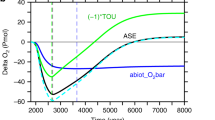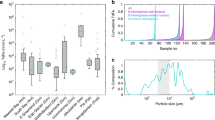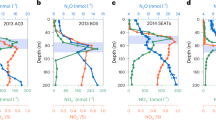Abstract
THE equatorial Pacific Ocean is a 'high-nitrate, low-chlorophyll' region where nitrate and phosphate are abundant all year round. These nutrients cannot therefore be limiting to phytoplankton production. It has been suggested that the bioavailability of iron—a micronutrient—may be preventing full biological utilization of the major nutrients1–3. The results of a previous in situ iron fertilization experiment in this region provided support for this hypothesis4, but the observed biological response resulted in only a small decrease in surface-water CO2 fugacity5. Here we report a much larger, biologically induced uptake of surface-water CO2 that occurred during a second study6. The fugacity of CO2 in the centre of the (iron-fertilized) patch of surface ocean fell from a background value near 510 μatm to approximately 420 μatm, corresponding to a transient 60% decrease in the natural ocean-to-atmosphere CO2 flux. We conclude that iron supply to this ocean region can strongly modulate the local short-term source of CO2 to the atmosphere, but has little long-term influence on atmospheric CO2 partial pressure. However, if such a modulation also occurs in the Southern Ocean, then iron bioavailability at high southern latitudes could have a significant effect on atmospheric CO2 partial pressure7–11, for example over glacial–interglacial periods.
This is a preview of subscription content, access via your institution
Access options
Subscribe to this journal
Receive 51 print issues and online access
$199.00 per year
only $3.90 per issue
Buy this article
- Purchase on Springer Link
- Instant access to full article PDF
Prices may be subject to local taxes which are calculated during checkout
Similar content being viewed by others
References
Hart, T. J. Discovery Rep. 8, 1–268 (1934).
Moore, R. M., Milley, J. E. & Chatt, A. Oceanologica Acta 7, 221–228 (1984).
Martin, J. H. & Fitzwater, S. E. Nature 331, 341–343 (1989).
Martin, J. H. Nature 371, 123–129 (1994).
Watson, A. J. et al. Nature 371, 143–145 (1994).
Coale, K. et al. Nature 383 495–501 (1986).
Sarmiento, J. L. & Orr, J. C. Limnol. Oceanogr. 36, 1928–1950 (1991).
Peng, T.-H. & Broecker, W. S. Nature 349, 227–229 (1991).
Joos, F., Sarmiento, J. L. & Siegenthaler, U. Nature 349, 772–775 (1991).
Kurz, K. D. & Maier-Reimer, E. Glob. Biogeochem. Cycles 7, 229–244 (1993).
Siegenthaler, U. & Sarmiento, J. L. Nature 365, 119–125 (1993).
DeBaar, H. J. W. et al. Mar. Ecol. Prog. Ser. 65, 34–44 (1990).
Hudson, J. M. & Morel, F. M. M. Limnol. Oceanogr. 35, 1002–1020 (1990).
Coale, K. H. Limnol. Oceanogr. 36, 1851–1864 (1992).
Cooper, D. J., Watson, A. J. & Ling, R. D. Mar. Chem. (submitted).
Takahashi, T., Olafsson, J., Goddard, J. G., Chipman, D. W. & Sutherland, S. C. Glob. Biogeochem. Cycles 7, 843–887 (1993).
Wanninkhof, R., Ledwell, J. R. & Watson, A. J. J. Geophys. Res. 96, 8733–8740 (1991).
Upstill-Goddard, R. C., Watson, A. J., Wood, J. & Liddicoat, M. I. Analytica Chim. Acta 249, 555–562 (1991).
Law, C. S., Watson, A. J. & Liddicoat, M. I. Mar. Chem. 48, 57–69 (1994).
Behrenfeld, M. et al. Nature 383, 508–511 (1996).
Watson, A. J., Liss, P. S. & Duce, R. A. Limn. Oceanogr. 36, 1960–1965 (1992).
Rue, E. L. & Bruland, K. W. Eos (Ocean Sci. Mtg) 77, 154 (1996).
Tans, P. P., Fung, I. Y. & Takahashi, T. Science 247, 1431–1438 (1990).
Wong, C. S., Chan, Y.-H., Page, J. S., Smith, G. E. & Bellegay, R. D. Tellus 45B, 64–79 (1983).
Feely, R. A. et al. Deep-Sea Res. II 42, 365–386 (1995).
Houghton, J. T. et al. (eds) Climate Change 1994: Radiative Forcing of Climate Change (Cambridge Univ. Press, 1995).
Martin, J. H. Paleoceanography 5, 1–13 (1990).
Kumar, N. et al. Nature 378, 675–680 (1995).
Mitchell, G., Brody, E. A., Holm-Hansen, O., McClain, C. & Bishop, J. Limnol. Oceanogr. 36, 1662–1677 (1991).
Martin, J. H., Fitzwater, S. E. & Gordon, R. M. Glob. Biogeochem. Cycles 4, 5–12 (1990).
DeBaar, H. J. W. et al. Nature 373, 412–415 (1995).
Author information
Authors and Affiliations
Rights and permissions
About this article
Cite this article
Cooper, D., Watson, A. & Nightingale, P. Large decrease in ocean-surface CO2 fugacity in response to in situ iron fertilization. Nature 383, 511–513 (1996). https://doi.org/10.1038/383511a0
Received:
Accepted:
Issue Date:
DOI: https://doi.org/10.1038/383511a0
This article is cited by
-
Carbon: nitrogen stoichiometry following afforestation: a global synthesis
Scientific Reports (2016)
-
A simulation of Asian dust events observed from 20 to 29 December 2009 in Korea by using ADAM2
Asia-Pacific Journal of Atmospheric Sciences (2013)
-
Impact of anthropogenic sources on aerosol iron solubility over the Bay of Bengal and the Arabian Sea
Biogeochemistry (2012)
-
C:N:P stoichiometry in soil: is there a “Redfield ratio” for the microbial biomass?
Biogeochemistry (2007)
-
Physiological state of phytoplankton communities in the Southwest Atlantic sector of the Southern Ocean, as measured by fast repetition rate fluorometry
Polar Biology (2005)
Comments
By submitting a comment you agree to abide by our Terms and Community Guidelines. If you find something abusive or that does not comply with our terms or guidelines please flag it as inappropriate.



